Biology mid year test revision
1/39
Earn XP
Description and Tags
Name | Mastery | Learn | Test | Matching | Spaced |
|---|
No study sessions yet.
40 Terms
why can simple, unicellular organisms rely on diffusion for the movement of substances in and out of the cell?
Simple, unicellular organisms can rely on diffusion because they have a high surface area-to-volume ratio, allowing for efficient exchange of substances due to the short distances involved.
what is the need for a transport system in multicellular organisms
Multicellular organisms have a higher demand for nutrients and oxygen due to larger size and higher metabolic rates.
Diffusion alone is insufficient to transport substances efficiently over long distances within the organism.
Transport system (e.g., circulatory system) facilitates rapid and controlled distribution of substances (nutrients, gases, hormones) to all cells.
Helps in removing waste products from cells to excretory organs.
what are Red Blood Cells (RBCs)
Main component responsible for carrying oxygen to tissues and removing carbon dioxide.
Contains hemoglobin, a protein that binds oxygen and gives blood its red color.
Biconcave shape increases surface area for gas exchange.
Lack a nucleus in mammals, allowing for more space to carry oxygen.
what are White Blood Cells (WBCs)
Part of the immune system, defending the body against infection and disease.
Types include neutrophils, lymphocytes, monocytes, eosinophils, and basophils.
Produced in bone marrow and lymphoid organs.
Can leave blood vessels (diapedesis) to reach infected or damaged tissues.
what are Platelets?
Cell fragments involved in blood clotting (hemostasis).
Released from bone marrow and help in sealing cuts and wounds.
Release clotting factors and form a temporary plug at the site of injury.
what is Plasma?
Yellowish liquid component of blood, composed mainly of water.
Carries various substances such as nutrients, hormones, waste products, and proteins.
Contains albumin (maintains osmotic pressure), globulins (antibodies and transport proteins), fibrinogen (clotting factor), and other proteins.
Acts as a medium for transporting blood cells, nutrients, hormones, and waste products throughout the body.
what is the role of plasma in the transport of substances in the human body?
Plasma is the liquid component of blood that transports nutrients, waste products, hormones, and gases throughout the body. substances dissolve in plasma and plasma is carried in the blood, this is how substances travel around the body.
how does the shape of red blood cells make them suitable for the transport of oxygen?
Red blood cells (RBCs) have a biconcave disc shape.
Increases the surface area-to-volume ratio, facilitating efficient diffusion of oxygen across the cell membrane.
Maximizes the amount of haemoglobin exposed to oxygen, enhancing oxygen-carrying capacity.
how do Red blood cells (RBCs) transport oxygen?
Oxygen combines with haemoglobin to form oxyhaemoglobin. The red blood cells are then transported around the body through arteries to different tissues in the body. When the red blood cells reach the respiring tissues the haemoglobin and oxygen split, the oxygen then diffuses into the respiring tissues for aerobic respiration to happen.
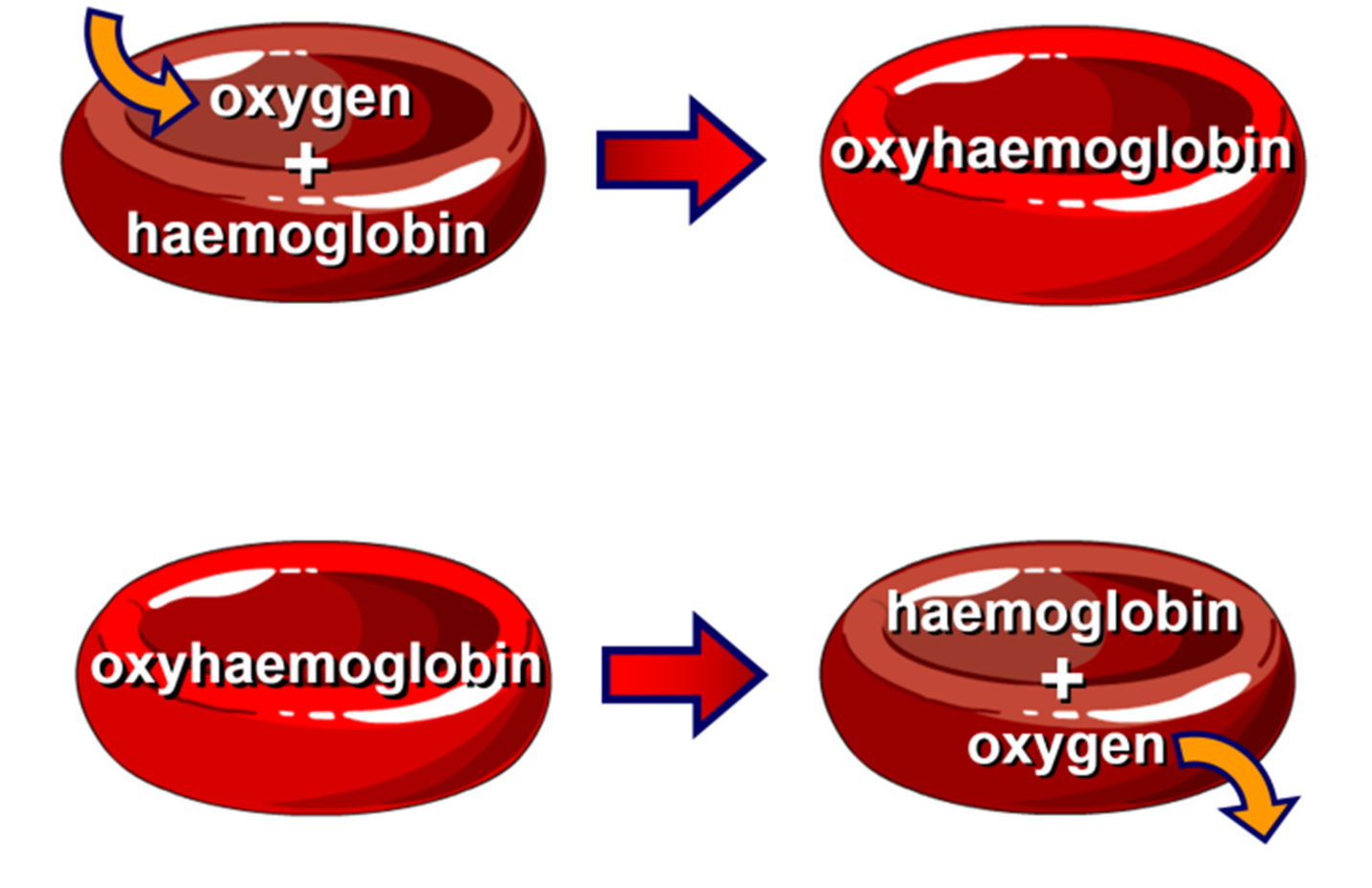
how does the absence of a nucleus in red blood cells make them suitable for the transport of oxygen?
Mature RBCs lack a nucleus.
Provides more space for hemoglobin, the protein responsible for binding and carrying oxygen.
Allows RBCs to be flexible and easily deformable, enabling them to squeeze through narrow capillaries to deliver oxygen to tissues.
how does presence of haemoglobin in red blood cells make them suitable for the transport of oxygen?
Haemoglobin is a protein inside RBCs that binds to oxygen in the lungs and releases it in tissues.
it create oxyhaemoglobin
Each haemoglobin molecule can bind up to four oxygen molecules.
Facilitates efficient oxygen transport throughout the body.
Gives RBCs their characteristic red color due to the iron-containing heme groups in hemoglobin.
how does the immune system respond to a disease?
a type of cell (called phagocytes) engulf and digest pathogens
the phagocyte detects the pathogen
it then surrounds (engulfs) the pathogen
phagocyte release lysosomes and digests the pathogen.
a type of WBC (called lymphocytes) produces antibodies and neutralises pathogen
lymphocyte detects pathogen
produces memory cells (which will attack the pathogen if it is in the human body again) and antibodies
antibodies bind to pathogen and clumps them together to neutralise them
this makes it easier for phagocyte to digest and engulf more than one pathogen at a time.
what is in a vaccination?
live inactive virus (eg TB)
bits of pathogen (eg HPV)
dead virus (eg cholera
Toxoid (eg tetanus)
how does a vaccination stop you from getting a disease?
body recognises what is in vaccine as harmful and releases lymphocytes
lymphocytes produces memory cells and antibodies
antibodies and phagocytes kill off what was in the vaccine
memory cells now exist in blood and will detect if virus/disease is back in blood and will neutralise/eliminate it.
ie:
Vaccination --> the body's lymphocytes make antibodies and memory cells
Subsequent infection (secondary response) --> memory cells recognise pathogenic antigens and make antibodies faster/sooner in greater quantities = no illness
what do platelets do and why are they important?
They are small colourless cell fragments in our blood that form clots that stop or prevent bleeding. They fill in the gaps between the red blood cells. This stops blood from getting out and stops pathogens from getting in.
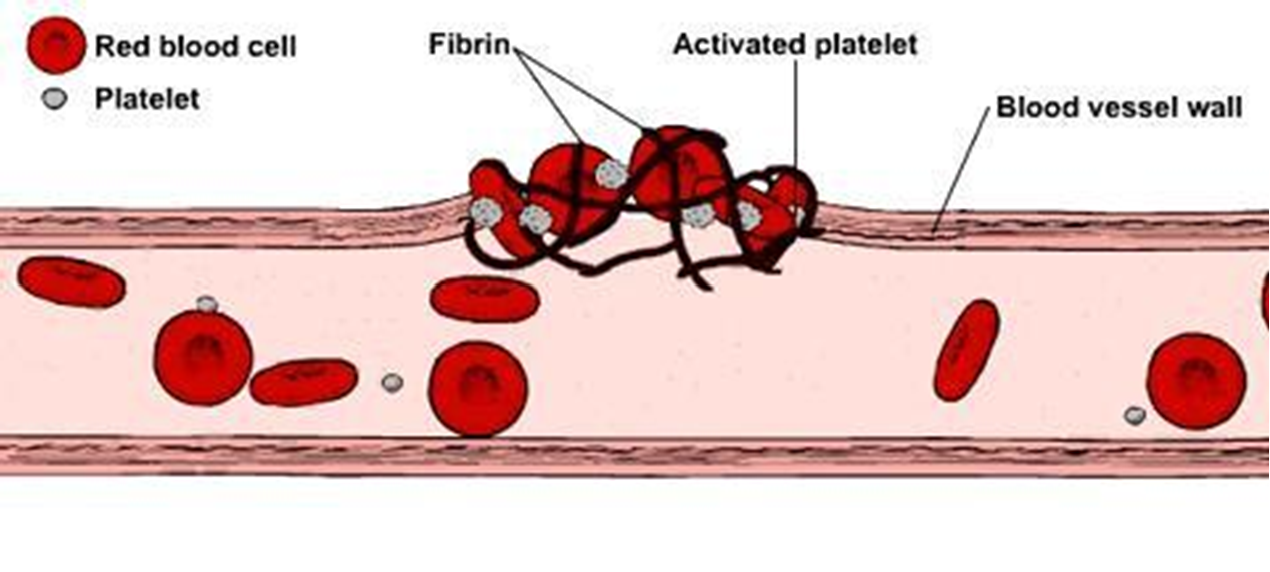
what is coronary heart disease (CHD)?
Coronary arteries deliver oxygenated blood to the heart muscle. The heart muscle, like all other tissues in the body, need oxygen-rich blood to function. In addition, oxygen-depleted blood must be transported away.
Fatty deposits block the coronary arteries, this will reduce blood flow to the heart muscle. This means less oxygen and glucose is able to get to the muscles and therefore cells can not respire, and will die.
factors that may increase risk of Coronary Heart disease
smoking
high blood pressure
diabetes
unhealthy diet
obesity
stress
physical inactivity
how does the structure of arteries relate to their function?
Structure:
Thick, muscular walls with elastic fibres.
Small lumen (inner space).
Endothelial lining.
Function
Carry oxygenated blood away from the heart to tissues.
Thick muscular walls help withstand high pressure from the heart's pumping action.
Elastic fibres allow arteries to stretch and recoil, maintaining blood pressure during the cardiac cycle.
Small lumen maintains high pressure to facilitate rapid blood flow.
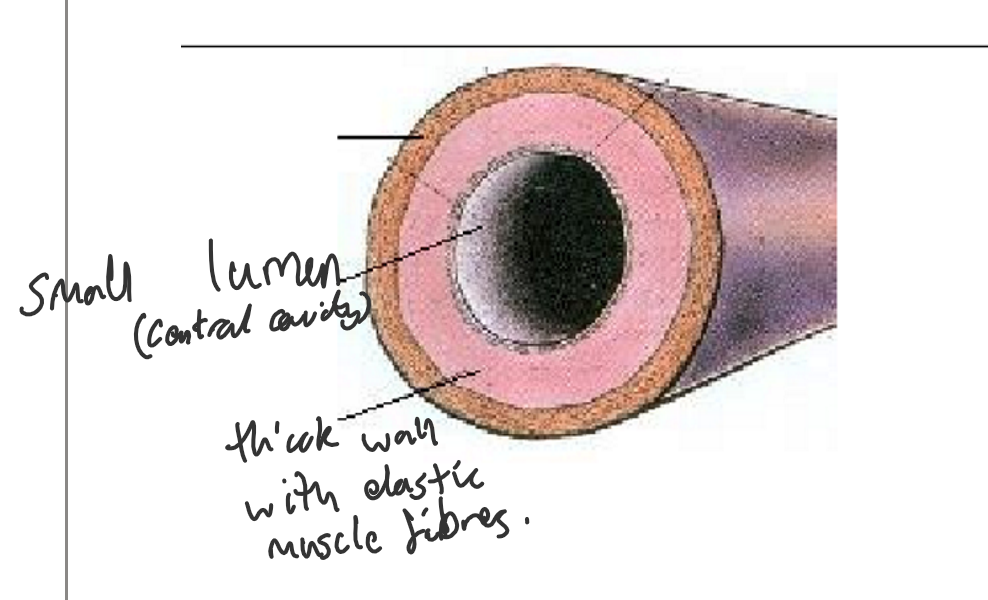
how does the structure of veins relate to their function?
structure:
Thinner walls compared to arteries.
Larger lumen.
Valves to prevent backflow of blood.
Endothelial lining.
Function:
Carry deoxygenated blood back to the heart from tissues.
Thinner walls and larger lumen allow veins to accommodate larger volumes of blood at lower pressure.
Valves prevent backflow of blood, ensuring one-way flow towards the heart.
Blood flow in veins is aided by skeletal muscle contractions and the respiratory pump.
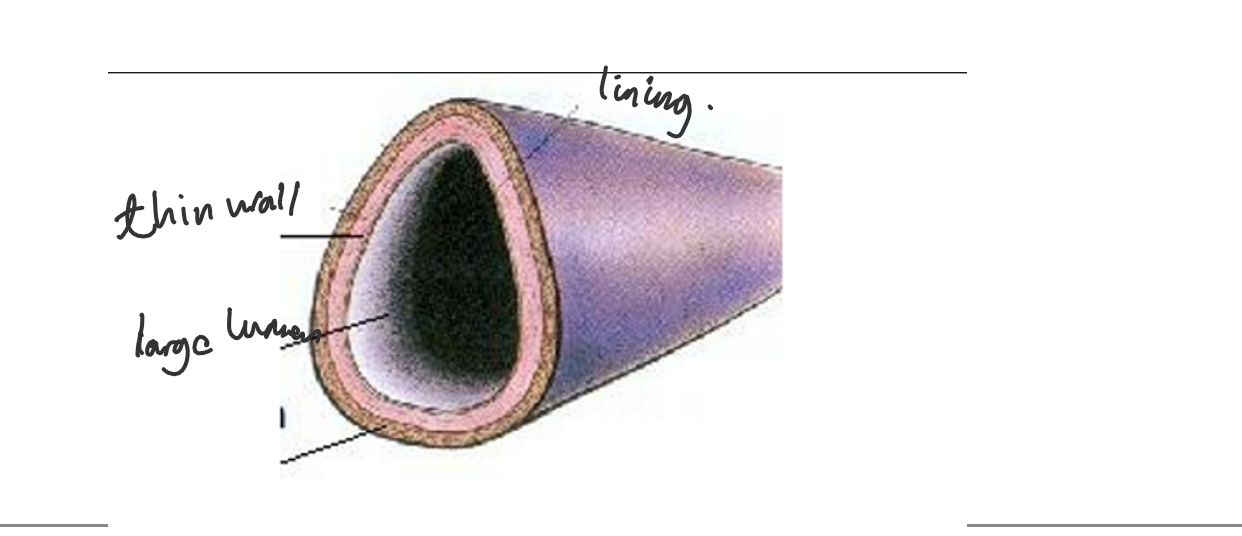
how does the structure of capillaries relate to their function?
Structure:
Single layer of endothelial cells.
Very small diameter.
Extensive network throughout tissues.
Function:
Site of exchange of nutrients, gases, and waste products between blood and tissues.
Endothelial cells are thin, allowing for easy diffusion of substances.
Small diameter ensures close proximity of blood to tissue cells, facilitating efficient exchange.
Extensive network provides a large surface area for exchange.
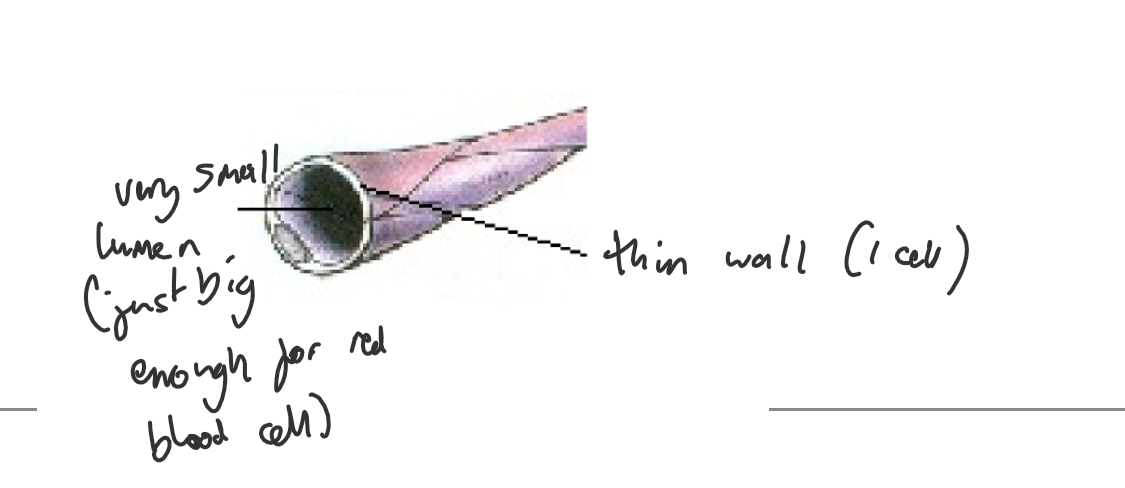
the general structure of the circulatory system, including the blood vessels connecting the heart and the lungs, the liver and the kidney
the structure includes arteries carrying oxygenated blood from the heart to organs, veins returning deoxygenated blood to the heart, and capillaries facilitating nutrient exchange in tissues.
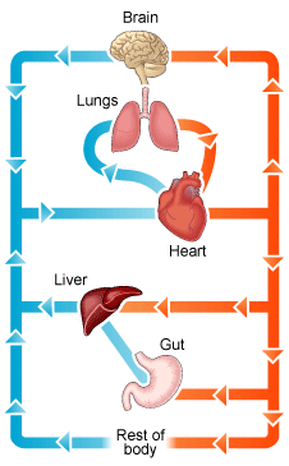
image of the circulatory system
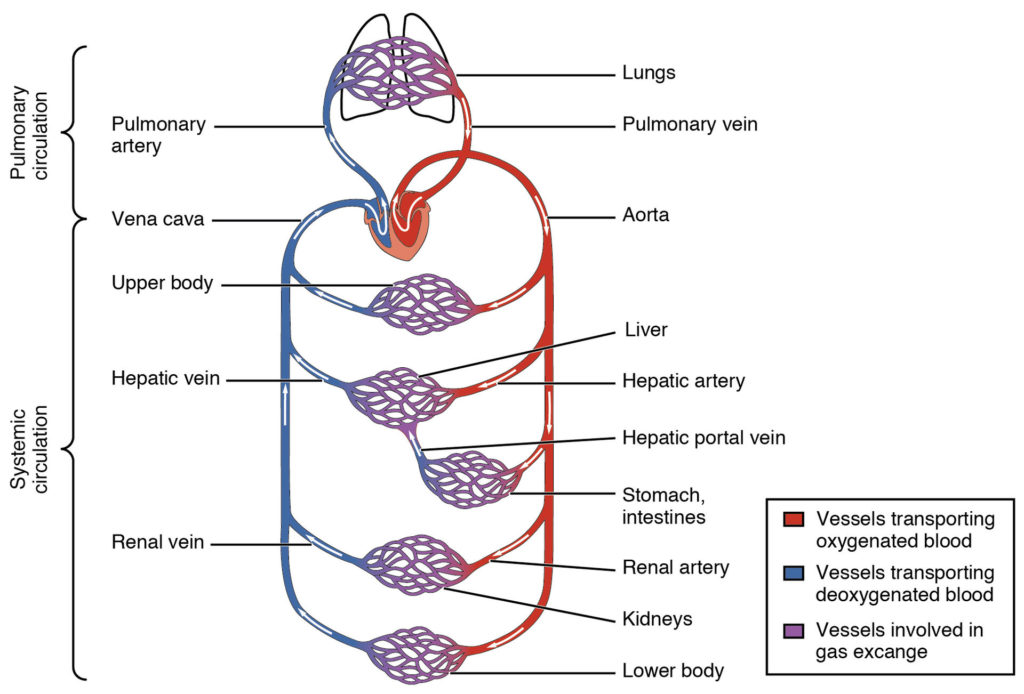
how are organisms able to respond to changes in their environment
Nervous System:
Detects changes in the environment using sensory receptors.
Processes information and generates responses through nerve impulses.
Rapid responses to immediate changes, such as avoiding danger or capturing prey.
what is homeostasis?
Homeostasis is the body's ability to maintain stable internal conditions despite external changes. It involves processes like temperature regulation and hormone balance.
what are the four components homeostasis (when the body detects a change in the environment)
Stimuli: is a change in the environment
Receptors: cells that detect changes in the environment
Coordination centres: areas that receive and process information. They coordinate a response
Effectors: muscles or glands that bring a response to the change
how does nervous communication control responses?
Nervous Communication:
Involves electrical impulses traveling along neurons (nerve cells).
Rapid response system for immediate reactions to stimuli.
Sensory receptors detect stimuli (e.g., touch, light, sound) and convert them into electrical impulses.
Impulses travel along sensory neurons to the central nervous system (brain and spinal cord).
Central nervous system processes information and generates appropriate responses.
Motor neurons carry impulses from the central nervous system to effectors (muscles or glands).
Effectors carry out responses (e.g., muscle contraction or hormone secretion) in reaction to the stimulus.
Examples include withdrawing your hand from a hot object or blinking in response to a bright light.
how does hormonal communication control responses?
Hormonal Communication:
Involves chemical messengers called hormones.
Slower response system that regulates physiological processes and maintains homeostasis.
Endocrine glands (e.g., pituitary gland, thyroid gland) secrete hormones into the bloodstream.
Hormones are carried in the bloodstream to target cells or organs throughout the body.
Hormones bind to specific receptors on target cells, initiating cellular responses.
Responses can be short-term (e.g., increased heart rate in response to stress) or long-term (e.g., growth and development).
Examples include regulation of blood glucose levels by insulin and glucagon, and control of metabolism by thyroid hormones.
explain the differences between nervous and hormonal responses
Speed: Nervous communication is faster, transmitting impulses at speeds of meters per second, while hormonal communication is slower, taking seconds to minutes for hormones to travel through the bloodstream.
Duration: Nervous responses are short-lived, lasting milliseconds to seconds, while hormonal responses can be long-lasting, lasting minutes to days.
Mode of Transmission: Nervous communication involves electrical impulses along neurons, while hormonal communication involves chemical messengers (hormones) carried in the bloodstream.
Specificity of Target: Nervous communication typically targets specific cells or organs, while hormonal communication affects multiple target cells or organs throughout the body.
Adaptation to Stimuli: Nervous responses are well-suited for rapid adaptation to immediate changes in the environment, while hormonal responses are better suited for slower, long-term regulation and maintenance of physiological processes.
what are the two parts to the central nervous system (CNS)?
the spinal chord
the brain
what are the three types of neurones?
motor neurone (connects CNS and effectors)
relay neurone (connects sensory neurone and motor neurone)
sensory neurone (connects receptor organs and CNS)
image of the three types of neurones
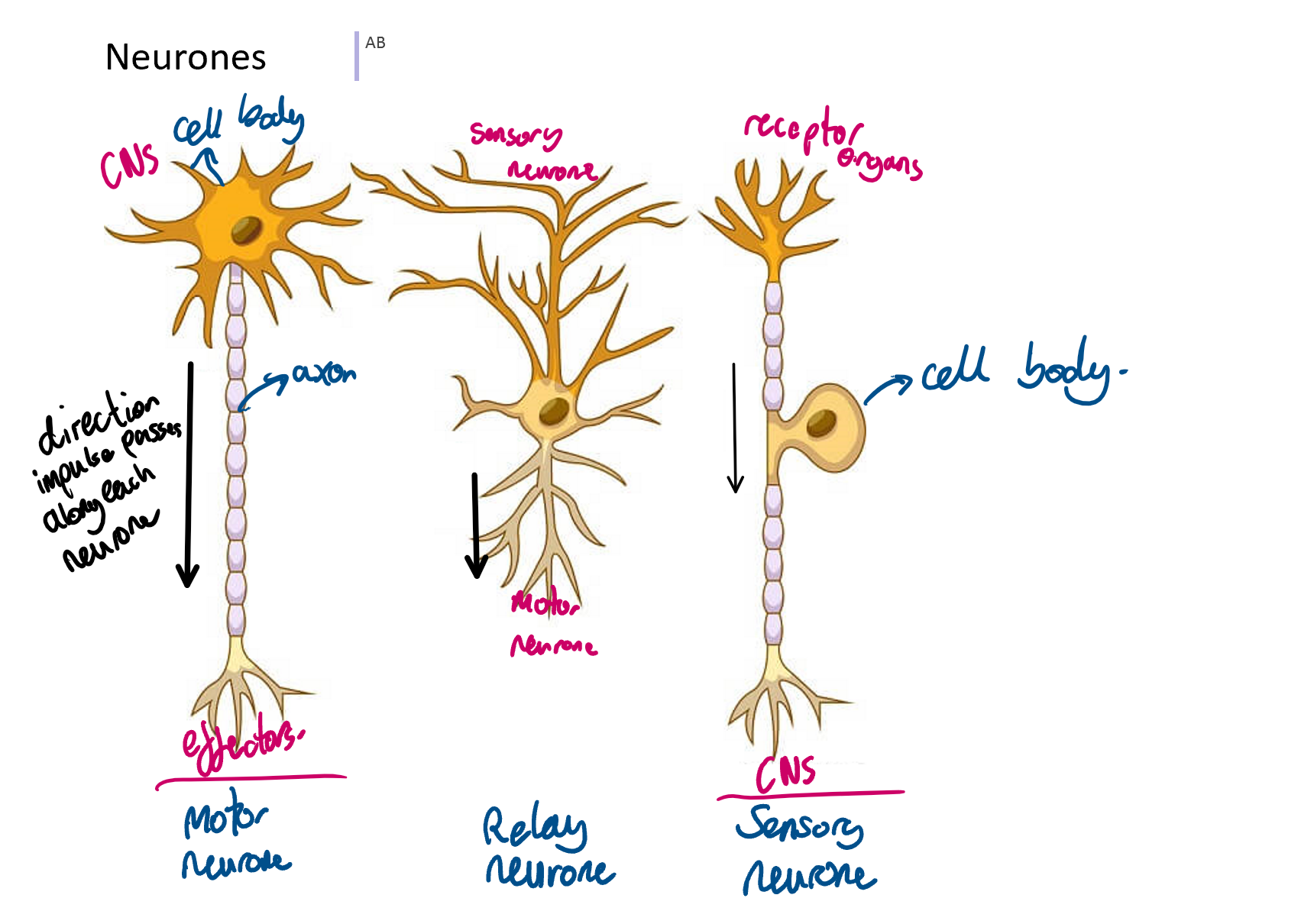
what is the role of neurotransmitters at synapses?
Neurotransmitters are chemical messengers that transmit signals across synapses, the junctions between neurons or between neurons and other cells (e.g., muscle cells or gland cells).
Neurotransmitters play a crucial role in neuronal communication, synaptic plasticity (the ability of synapses to strengthen or weaken over time), and the regulation of various physiological processes in the nervous system.
what do neurotransmitters do?
When a nerve impulse reaches the axon terminal of a presynaptic neuron, it triggers the release of neurotransmitters from synaptic vesicles into the synaptic cleft, the small gap between the presynaptic and postsynaptic neurons.
Neurotransmitters diffuse across the synaptic cleft and bind to specific receptors on the postsynaptic neuron's membrane.
Binding of neurotransmitters to receptors causes changes in the postsynaptic neuron's membrane potential, either depolarizing or hyperpolarizing it.
If the membrane potential reaches a threshold, it may trigger the generation of an action potential in the postsynaptic neuron, propagating the signal.
Neurotransmitters can either excite (excitatory neurotransmitters) or inhibit (inhibitory neurotransmitters) the postsynaptic neuron, influencing its likelihood of generating an action potential.
After neurotransmitter action, they are rapidly removed from the synaptic cleft through processes like enzymatic degradation, reuptake by presynaptic neurons, or diffusion away from the synapse.
what is vasoconstriction?
Vasoconstriction is the narrowing of blood vessels, reducing blood flow and increasing blood pressure. It is controlled by the nervous system and hormones like adrenaline.
Vasoconstriction occurs when the body is cold.
what is vasodilation?
Vasodilation is the widening of blood vessels, increasing blood flow and reducing blood pressure.
Vasodilation occurs when the body is hot.
how is the male reproductive system adapted to fit its functions?
Testes:
Located in the scrotum outside the body.
Produces sperm through spermatogenesis.
Contains seminiferous tubules where sperm are produced and matured.
Sperm production occurs at a temperature slightly lower than body temperature, facilitated by scrotal position.
Vas Deferens (sperm duct):
Muscular tube that carries sperm from the epididymis to the urethra during ejaculation.
Lined with smooth muscle for peristaltic contractions to propel sperm.
Penis:
Organ for copulation and ejaculation of sperm into the female reproductive tract.
Contains erectile tissue that becomes engorged with blood during arousal, enabling erection for sexual intercourse.
how is the female reproductive system adapted to fit its functions?
Ovaries:
Paired organs that produce eggs (ova) through oogenesis.
Release mature eggs during ovulation into the fallopian tubes.
Fallopian Tubes (Oviducts):
Muscular tubes that transport eggs from the ovaries to the uterus.
Site of fertilization, where sperm meet and fertilize the egg
Uterus:
Hollow, muscular organ where fertilized eggs (embryos) implant and develop during pregnancy.
Contains endometrium lining that thickens during the menstrual cycle to support embryo implantation.
Cervix:
Lower part of the uterus that connects to the vagina.
Contains cervical mucus that changes consistency to facilitate or prevent sperm entry into the uterus.
Vagina:
Elastic, muscular tube that receives the penis during sexual intercourse.
Functions as the birth canal during childbirth and as the outlet for menstrual flow.
Contains acidic pH to protect against infections and maintain vaginal health.
how are, both, the structure of the male and female reproductive systems are adapted to their functions
Male and female reproductive systems are adapted to produce and transport gametes (sperm and eggs), facilitate fertilization, support embryo development, and enable copulation and childbirth.
Each structure within the reproductive systems is specialized to perform specific functions necessary for reproduction and the continuation of the species.
what is the role of the placenta in the nutrition of the developing embryo?
The placenta is an organ that provides oxygen and nutrients to the developing embryo and removes waste products, acting as a bridge between the mother and the foetus.
It filters the unnecessary and dangerous substances the baby may be recieving.
why is the developing embryo protected with amniotic fluid?
Amniotic fluid protects the developing embryo by cushioning it from physical trauma, maintaining a stable temperature, preventing dehydration, and allowing for foetal movement.